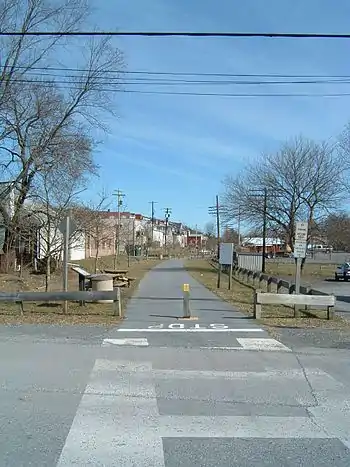Western Maryland Rail Trail
The Western Maryland Rail Trail (WMRT) is a 22.5-mile (36.2 km) long shared-use asphalt-paved rail trail from Fort Frederick to Pearre Station, Maryland, United States, that is suitable for walkers, joggers, bikers, rollerbladers and, weather permitting, cross country skiing and snowshoeing.

The trail runs on the abandoned right-of-way of the Western Maryland Railway's West Subdivision. The line was officially abandoned in 1975 and the final train on the line, a work train that removed the rails between Big Pool and Tonoloway, was run in December 1988. The portion through the C&O Canal National Park reverted to the Park Service in 1980.[1] In August 1990, the Maryland Department of Natural Resources purchased the right-of-way from 1/2 mile west of Fort Frederick State Park to Little Orleans through Hancock from CSX Transportation. Construction began on the first ten-mile (16 km) section from Fort Frederick to Hancock in 1997 and was completed in 1998. The second section, running 10.3 miles (16.6 km) from Hancock to Pollypon, a small body of water where canal boats would winter, began in 2001 and opened on June 10, 2002. Construction began on the third section, a 2.1-mile (3.4 km) extension from Pollypon to Pearre Station in 2003 and it opened in 2005.[2]
The trail was originally intended to continue along National Park Service land all the way to a point just across the river from Paw Paw, WV, but due to environmental concerns and the risk to bat habitat it is now to end at Little Orleans, MD. The 4.5-mile (7.2 km) extension to Little Orleans was originally funded in 2005, when the trail was still intended to go to Paw Paw.[3][4] After a 2008 study found bats living in the tunnels, an environmental assessment was undertaken to determine the feasibility of using the tunnels for the trail.[5][6] The environmental impact study determined that the Indigo tunnel houses the largest known bat refuge in Maryland. The tunnel is one of the largest hibernaculum of five species of bats, including the Eastern Small-footed bat and the Indiana bat (both currently listed as endangered) as well as numerous other bats. In 2010, following a survey done in March of that year, Maryland state officials and the National Park Service agreed that the trail would bypass the Indigo Tunnel to protect the bat population.[7] Instead the extension will use the C&O Canal towpath to bypass the tunnel within the Chesapeake and Ohio Canal National Historical Park. In 2012, the National Park Service completed the Environmental Assessment for the extension of the Western Maryland Rail Trail between Pearre and Paw Paw.[8] It included several alternatives that would extend the trail between 8.1 and 14.4 miles, including options to either run the trail through, or build bypasses around Stickpile and Kessler Tunnels. The Park Service selected the alternative that would do neither, and instead chose to extend the trail 7.2 miles to the entrance to Stickpile Tunnel where it would terminate, and then add an additional 0.9 mile section on the west side from the bridge over the C&O Canal near Paw Paw to the 5th Potomac River Crossing on the north side of Bevan Bend.[9] Bypassing the Stickpile Tunnel was possible, but the topography around Kessler was found to be too challenging. As a result, the extension through the Paw Paw Bends west of Little Orleans was placed on indefinite hold in 2014.[10] By 2016, West Virginia had dropped out of the plan, and so the sections from Little Orleans to Stickpile tunnel and the western 0.9 mile section were dropped.[11]
Phase IV to Little Orleans has been frequently delayed with start dates delayed from 2012, 2014 and 2016.[12][11][7] The project finally went out to bid in May 2017.[13]
References
- "Indigo Tunnel Bat Habitat - Installation of Bat Gates, Interim Closure". Retrieved 28 September 2017.
- "DNR Announces Third Phase Of Work Completed On Western Maryland Rail Trail". Maryland Department of Natural Resources. 2005-05-19. Archived from the original on 2005-05-27. Retrieved 2007-04-09.
- "Governor Ehrlich Announces Funding To Expand Western Maryland Rail Trail In Washington County". Maryland State Highway Administration. 2005-06-01. Retrieved 2006-12-21.
- Reilly, Tara (7 October 2005). "Western Maryland Rail Trail to expand 4.5 miles". Retrieved 28 September 2017.
- Johnson, Joshua; Gates, J. "Bat Communities at Abandoned Railroad Tunnels in Chesapeake and Ohio Canal National Historical Park" (PDF). Retrieved 28 September 2017.
- Roylance, Frank (15 November 2008). "Bats versus bicyclists". Retrieved 28 September 2017.
- Roylance, Frank (27 July 2010). "State going to bat for the bats". Retrieved 28 September 2017.
- "Meetings scheduled for proposed extension of Western Maryland Rail Trail". 11 May 2012. Retrieved 28 September 2017.
- NCR Parks ESA Section 7 Consultations--Bundled Northern Long-eared Bat—Threatened. September 2016. p. 5.
- McVey, John (2014-01-27). "Proposed plan to extend path shelved". The Journal. Retrieved 2014-01-27.
- "DNR Trail News: March 2016 – May 2016". Archived from the original on 30 July 2016. Retrieved 29 June 2016.
- McVey, John (2014-01-27). "WMRT to be extended to Potomac". The Journal. Retrieved 2014-01-27.
- "Bid Solicitation: MDDGS31031959". Retrieved 28 September 2017.
The new section was competed, opened, and dedicated in May, 2019.